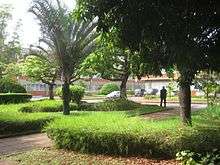Centro de Pesquisa e Desenvolvimento em Telecomunicações
CPQD is a Research and Development Center in Telecommunications and one of the largest Latin American R&D centers in Telecommunications and IT.[1] Located in Campinas, São Paulo, Brazil, CPQD has operated as a contractor for institutions and enterprises in a wide range of fields: telecommunications, finance, energy, industrial, corporate and public administration.[1]


History
CPQD was founded in 1976, as a Telecom research and development center for Telebras. In 1998, with the privatization of Telebras, CPQD became an independent Foundation.[2]
Selected projects
The CONVERTE Project, started in 2003 in partnership with Trópico Telecomunicações Avançadas, developed new technologies for convergent next-generation networks.[3]
CPQD has participated in the development of the Brazilian digital television system (SBTVD).[4]
The GIGA Project, developed by CPQD along with several other research institutions, is focused on the development of new technologies for high speed optical networks.[5]
In 2013, CPQD made a partnership with the Brazilian Ministry of Defence to develop communication technologies for the Brazilian Armed Forces.[6]
References
- "CPQD Identity". Retrieved 15 Aug 2015.
- "Historic background". Retrieved 15 Aug 2015.
- "Inovação na CELG, no GIGA e no CONVERTE". Retrieved 15 Aug 2015.
- "Sistema Brasileiro de Televisão Digital (SBTVD)". Retrieved 15 Aug 2015.
- "GIGA Project". Retrieved 15 Aug 2015.
- Granzotto, Luiz. "CPQD inaugura centro de desenvolvimento de comunicação para as Forças Armadas". Folha de Campinas. Archived from the original on 2014-08-14. Retrieved 15 Aug 2015.
External links
| Wikimedia Commons has media related to CPqD. |
- CPQD - Connect to the new
- GIGA Project (in Portuguese)
- Trópico Telecomunicações Avançadas